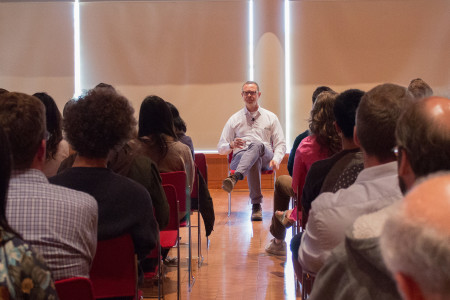Renowned for being one of the first journalists to document Chinese immigration to Africa, Howard French, associate professor at the Columbia University Graduate School of Journalism and two-time Pulitzer Prize nominee, spoke on Wednesday, April 15, in JRC 101 about his new book, titled “China’s Second Continent: How a Million Migrants are Building a New Empire in Africa.” The Rosenfield Program in Public Affairs, International Relations and Human Rights sponsored French’s talk.
Professor Leif Brottem, Political Science, introduced French and was instrumental in bringing him to campus. Brottem explained that he has been working for several months to arrange French’s visit, and that he has found French’s body of research to be incredibly interesting and proximate to his own body of work.
“I read his column when he was a journalist. When I started getting interested in Africa, which is where I do research, he was one of the main NYT correspondents in Africa,” Brottem said. “I’m … looking forward to the conversation in the Grinnell community with him, and how he responds to that.”
French began his career as a journalist in Africa, where he worked as a freelance reporter for The Washington Post. He later moved to Japan and then China, and in his Shanghai office he began to notice a steady stream of African heads of state, which prompted him to investigate the presence of Chinese immigrants all around Africa.
“I arrived in China in 2003 … and I noticed delegation after delegation of African heads of state,” French said. “I wasn’t in China to write about Africa, but I look out the window and I’m seeing the frequency of African heads of state … It became apparent that there was a really big push to expand contact with the Africans.”
French described how in the following months, he visited Ethiopia, Chad and Malawi looking for Chinese engagement in the community and writing about China’s big push into the continent, which was not as difficult because French is fluent in Mandarin and could communicate with Chinese laymen who he encountered randomly on the street, like he did in Dakar, Senegal. French also criticized other attempts to write about Chinese in Africa as all taking place from the “30,000 foot perspective.”
“I … came to the conclusion that most of the writing on this topic is from … what I fancy as the 30,000 foot perspective, as if you’re riding an airplane, looking down,” he said. “You’re not really seeing anything in great detail. You’re not going to get into any detail at all.”

Photo by Rae Kuhlman.
French credited his long-term personal and historical perspective on Chinese in Africa as the result of being a journalist since the early 1980s and “having the visual sense and personal perspective” that informed his understanding of Chinese people. Subsequently, French recalled that after China’s “big coming out party” in 2008, he travelled to Tanzania, Zambia and the Congo after he was asked to write for The Atlantic magazine about China’s involvement on the continent.
“There were these big meta questions about who’s winning and who’s losing—big questions about China’s rise, at whose expense,” French said. “Is this good for Africa, or will this devastate Africa?”
He attributes much of this fear to concerns about China’s rapid economic rise and feelings of “yellow peril,” a term describing racial anxieties of Asian people, and misinformed stereotypes of Africa as being poor, dangerous and lacking high levels of civilization.
French also described how in the 1990s Chinese migration to Africa frequently centered on infrastructure projects which required large amounts of skilled, blue-collar labor, who stayed afterwards in an environment so different from home, which for most of them was the Hunan Province in Central China. He also noted how that migration translated into the huge number of Chinese immigrants in Africa today.
“If you’re from Central China, the notion of open land is completely inconceivable,” French said. “[It] gave China a chance to compete with the most competitive, most profitable markets without established rivals for globalization.”


















































